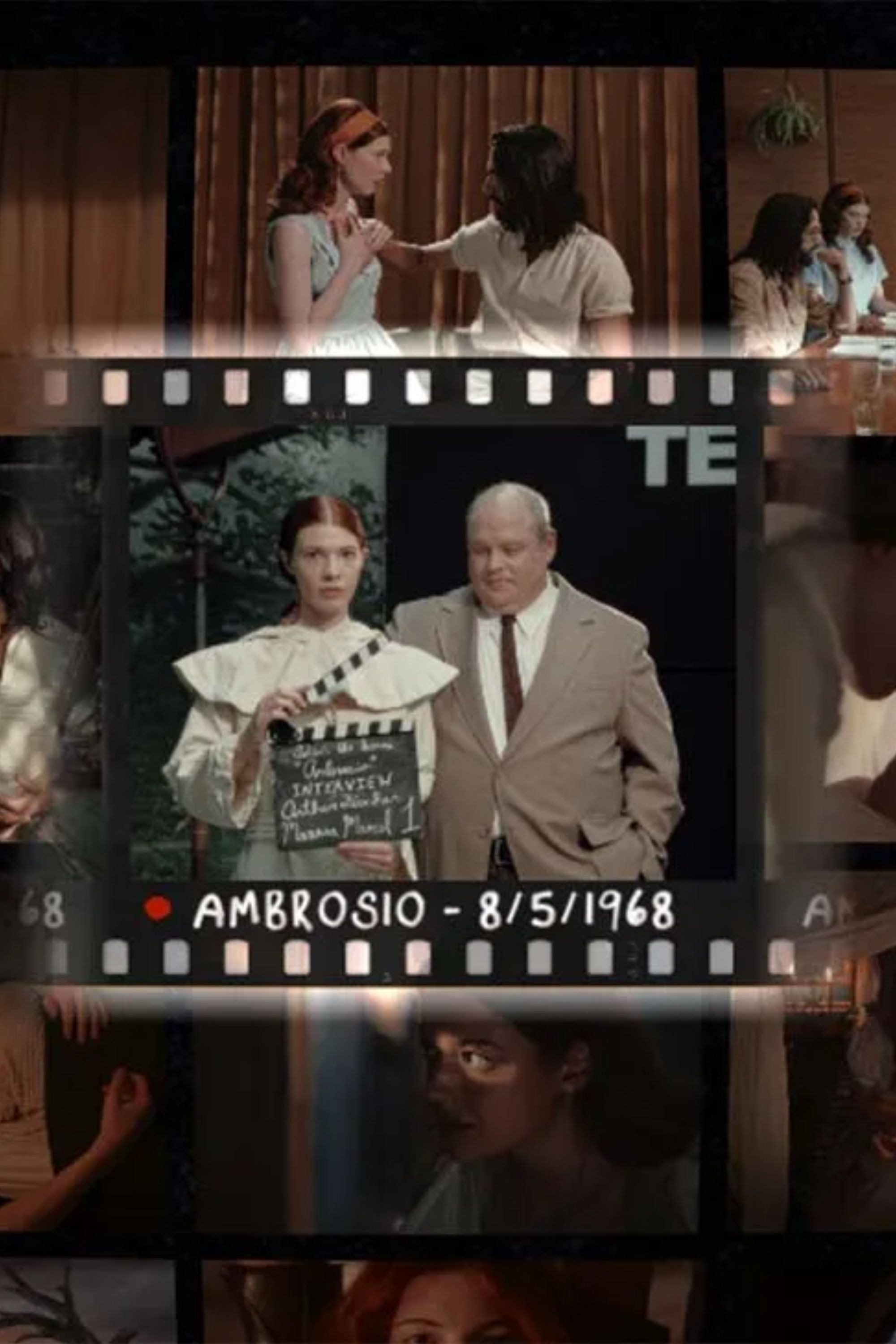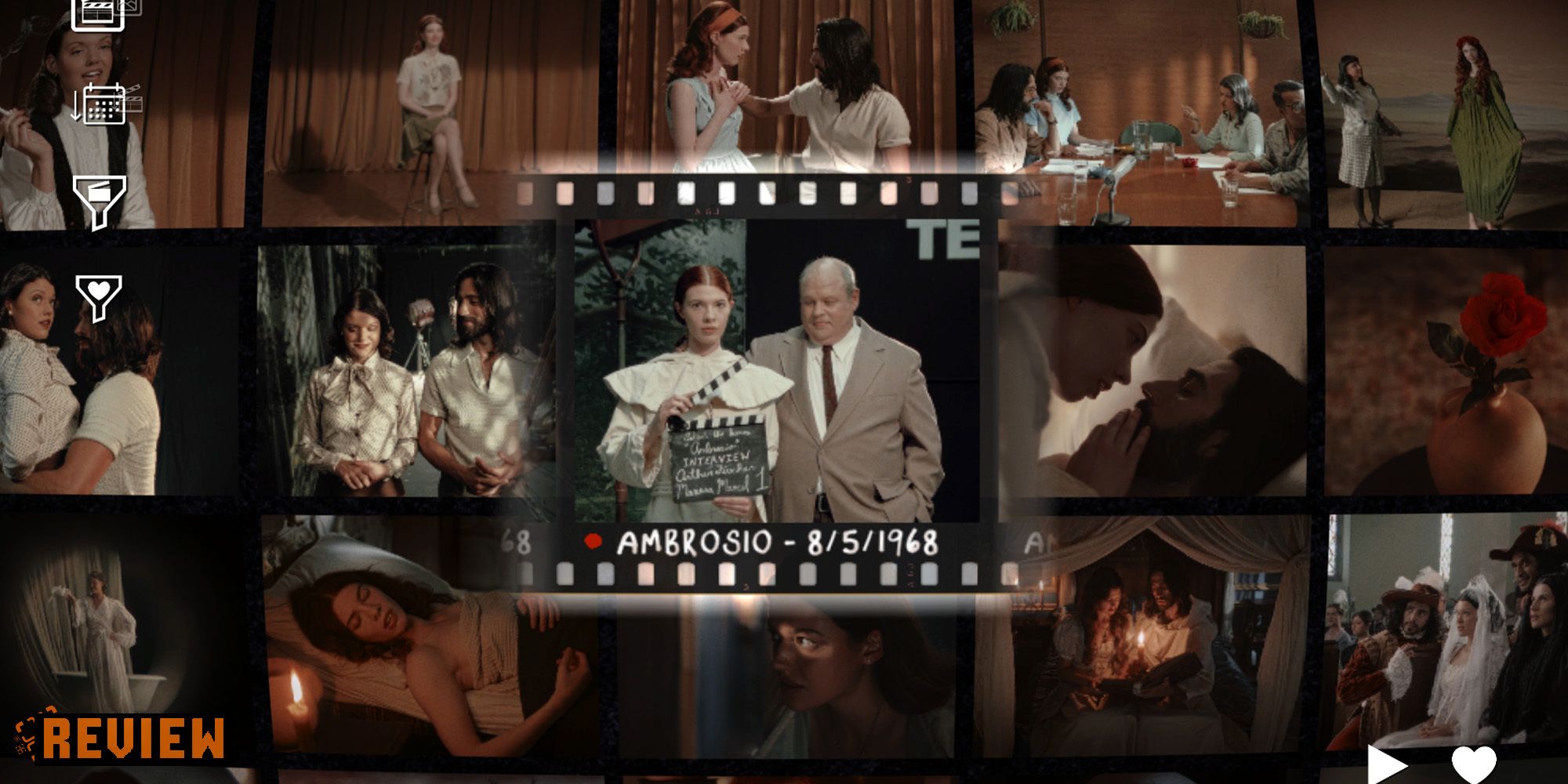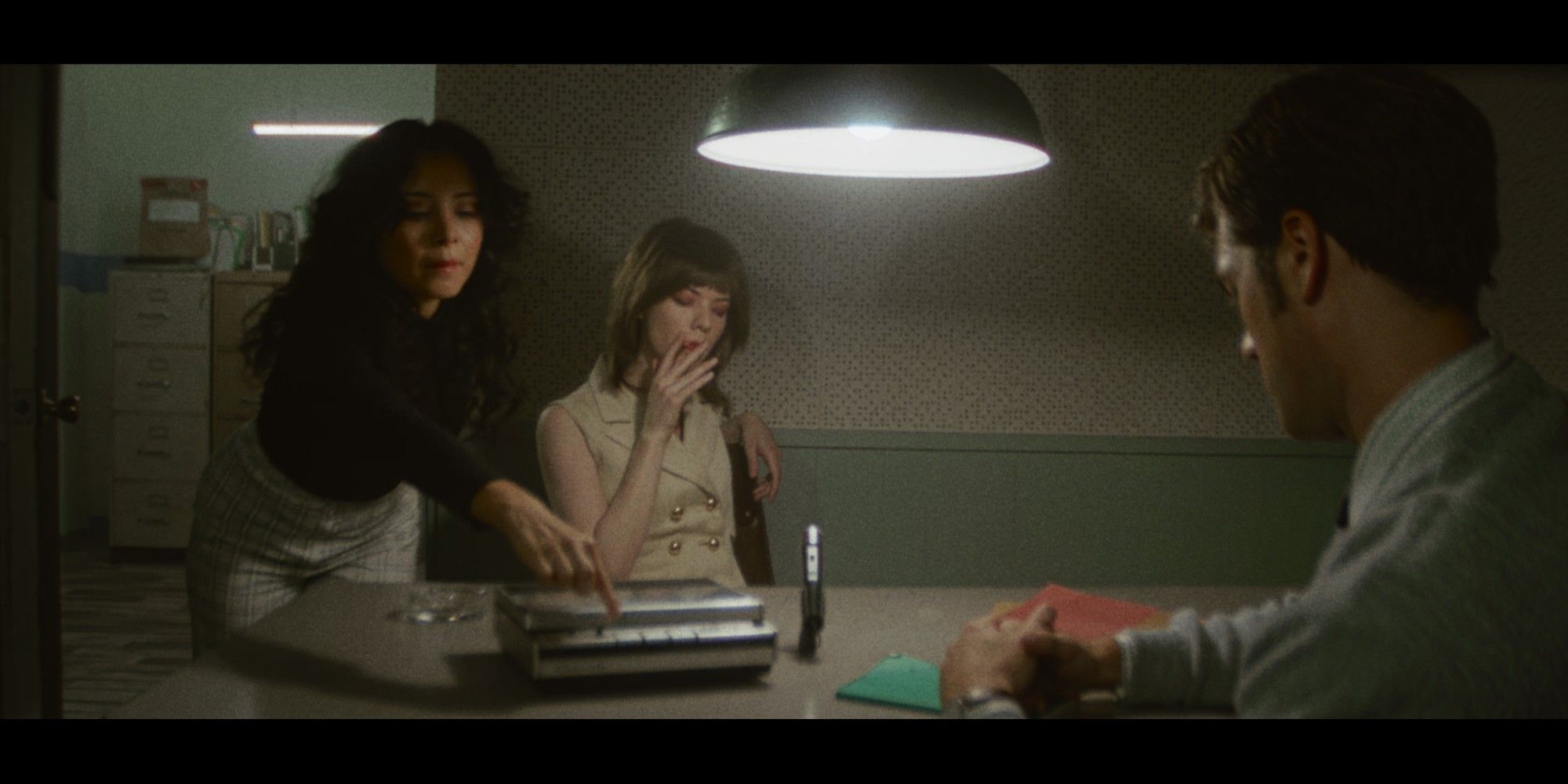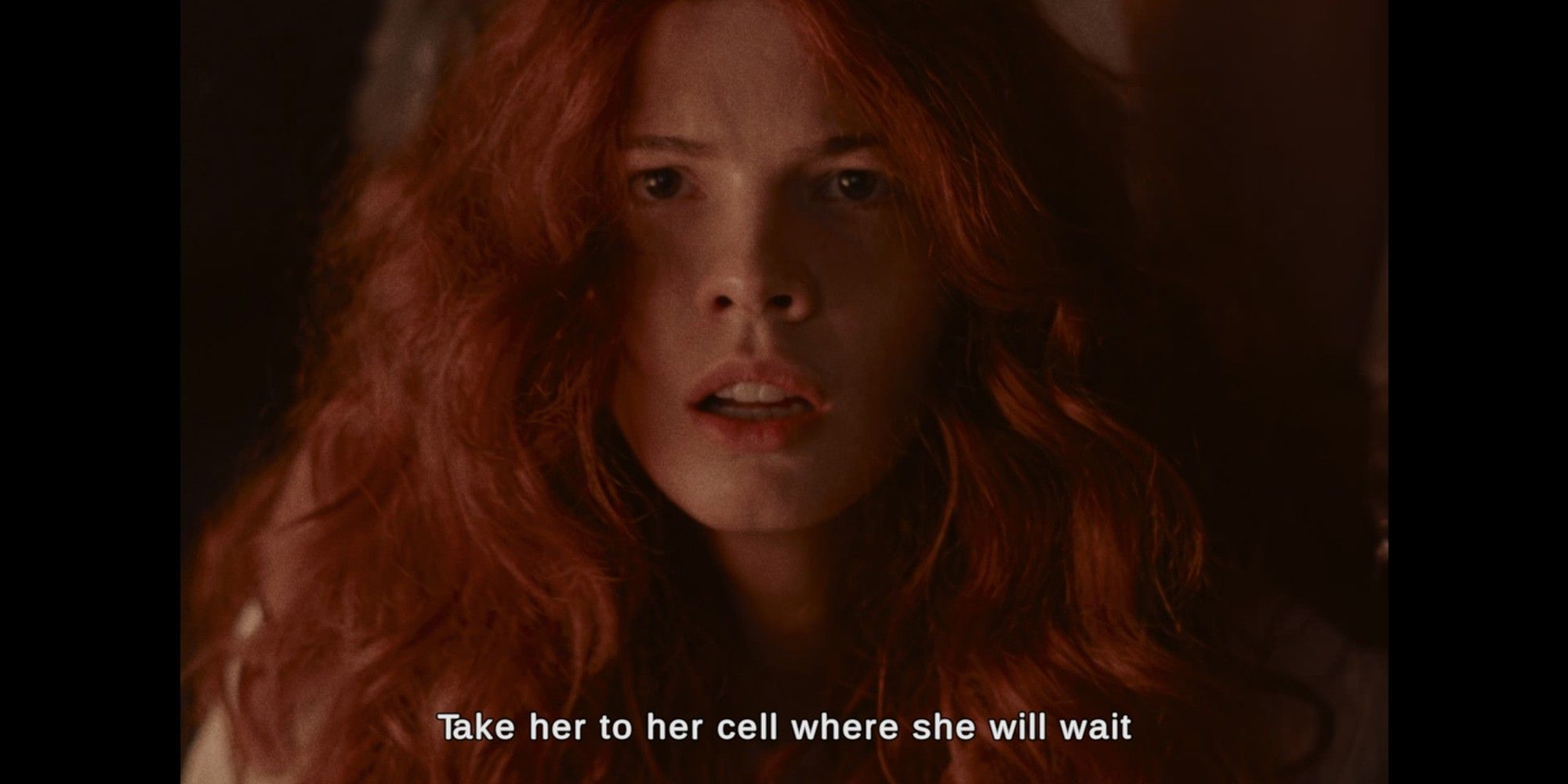In Immortality, the first clip you uncover finds long lost star Marissa Marcel on a fictionalized version of The Tonight Show. After chatting for a bit, Jimmy, the show's Johnny Carson equivalent, rolls a clip from Marcel's film, Ambrosio. The footage is grainy and low quality, the way it really would have looked if shown on a talk show in 1968. Keep playing and you will eventually find that shot in its original form. In both iterations, the take is framed in 4:3, the boxy aspect ratio that many films of that era were shot in. But, in the original shot the image is pristinely clear, only bearing the grain of celluloid, not the staticky fuzz of TV.
As you find footage from Minsky and Two of Everything, the two other unreleased films that Marcel starred in, the image quality changes to reflect the times. Minsky is shot in an anamorphic widescreen that aligns with other gritty detective movies of the decade. Two of Everything's film stock looks visibly newer, with less obvious grain and a fullscreen ratio. As you watch behind-the-scenes footage from each production, the quality varies as well, with Super 8 interviews with Minsky's cast and digital video recordings of Two of Everything's rehearsals.
I'm opening this review with a lot of technical information because in this game those specs matter as much as genre or graphical style would in another. Developer Half Mermaid's commitment to capturing each era's footage in formats that look like they could believably come from their given time roots each production in the period it was filmed. Though it's called Immortality, the game is deeply concerned with the transient; with filmmaking techniques and the movements employing them that rose to dominance, only to become irrelevant in a few short years as technology and culture move on without them.
In his previous FMV games, Half Mermaid head Sam Barlow has gradually increased scope. Her Story began with one actress, sitting in one room, telling *ahem* her story to a police interrogator. In Telling Lies, the cast swelled to include four primary cast members, but, given that game's conceit — that your character was reviewing the footage from a cache of video calls where only one side of the conversation had been recorded — there was rarely more than one character on screen at a time. While many recent productions have shown signs of scaling back due to COVID restrictions, Immortality is Barlow's most expansive work yet, with dozens of cast members spread across three lost films, behind-the-scenes footage, and talk show appearances. Though a playthrough will only clock in around 8-12 hours for most players, if you put all the clips in the game together, you have rough cuts of three full movies.
Those three films all rest on the shoulders of Manon Gage, who rises to meet the mighty acting challenge this script presents. In Ambrosio, filmed in 1968, she is a young woman who infiltrates a monastery disguised as an adolescent boy. In Minsky, from 1970, she is the girlfriend of an artist found murdered and the primary suspect of the detective investigating the crime. And, in Two of Everything, filmed in 1998 and 1999, she is both an average woman and the pop star with whom she swaps places. Behind-the-scenes, she is Marcel, a charming ingenue plucked from obscurity by director Arthur Fischer for her role in Ambrosio. Later, Marcel sets out with that film's cinematographer John Durick to make Minsky, on which she gets a writing credit. After a death on the Minsky set, Marcel disappears from public life for nearly three decades, before returning to star in Durick's Two of Everything, after which she disappears again. Gage expertly plays all of these characters — sometimes multiple within the same scene — and believably captures Marcel at various stages of rehearsal. From the slightly theater kid-y line recitations of the initial table read to the naturalism of a final take, she modulates her performance perfectly.
Though Gage is unambiguously good, Marissa Marcel is an enigma. Despite 28 years passing between Minsky and Two of Everything, the actress looks exactly the same in the two films. That's one of the central mysteries you'll attempt to solve as you troll through Immortality's trove of film. As in Barlow's previous games, Immortality presents you with a central question — "What happened to Marissa Marcel?" — and gamifies the process of looking through the footage in a database until you find the solution. In Her Story and Telling Lies, keywords structured your search. When a character said "knife" or "attic" or "bomb," for example, you would type "knife" or "attic" or "bomb" into a search bar, then watch the clips that resulted hoping for a clue.
In Immortality, Half Mermaid has replaced that system with the more cinematic ability to search by match cut. It's a smart and intuitive change; it feels like a layer of separation between the player and the game has been removed. Instead of language mediating your gameplay, you can now, simply, click on an object or character in a shot and watch as the camera zooms in to that image, transitions to a similar image in a new shot, then zooms out to reveal the full picture. Though it's a definite improvement over the word search system, it falls a little short of what "search by match cut" brings to mind. While that choice of words suggests a transition between shots with similar compositions, you actually just move from one appearance of an object or character to another. It works well, but I think Half Mermaid may be able to dig deeper on a future project — exploring links between the compositions as a whole, not just the objects within them.
Though there is a set moment when credits roll, Immortality, like Barlow's previous work, is a game where you have to decide when you feel satisfied. That took me longer in Immortality than in past games. In part, that's because the game has a secret layer that is not immediately obvious at first. In my initial few hours, I mostly attempted to piece together the plot of each movie and the relationships binding the characters on and off screen. But doing so will only give you a small picture of what happened to Marissa Marcel. To get the whole story, the game invites you to go deeper. There is an uneasy weirdness to proceedings that takes some time to reveal itself.
Barlow has cited David Lynch as an influence on his work — Barry Gifford, Lynch's collaborator on Wild at Heart and Lost Highway co-wrote this game's excellent and sprawling script — but it's in this second search that the game becomes distinctly Lynchian. Video games and Lynch can make for strange bedfellows, at times. The mysteries that video games present are, generally, designed to be solved. But, Twin Peaks: The Return ends with a question, followed by a primal scream. Lynch's work doesn't provide easy answers. It may not provide answers at all. In that regard, Half Mermaid's games may be as well-suited to take inspiration from Lynch as any games being made today. Barlow's games are defined by the same uneasy relationship with reality as Lynch's films.
Immortality also shares Lynch's frank and, sometimes, discomfitting approach to sexuality and violence. Jimmy, that late night host, preps you for this early, asking Marissa about the nudity in Ambrosio. She responds by quoting the film's producer: "We are born naked and, if we are lucky, we die naked. So, why not shoot a movie naked?" Then she quips, "He kept his clothes on." Ambrosio and Minsky were produced in the liminal space of the late '60s and early '70s as the Old Hollywood (represented by bloated roadshow musicals like Doctor Dolittle and sword-and-sandals epics like Ben Hur) died and the New Hollywood (driven by young directors like Martin Scorsese, Steven Spielberg, Robert Altman, and Francis Ford Coppola) was being born. Ambrosio reflects the pageantry of the earlier era, with period appropriate garb and sets, but reflects a post-Hays Code willingness to depict sex and violence. Minsky, too, shows bloodshed and breasts, but feels more like a statement that would come from the New Hollywood, embracing the widescreen look and location shooting that gave the films of that era a gritty, verite feel. The game's embrace of sexuality and violence feels of a piece with the decade of filmmaking that its artifacts hail from.
Immortality feels like a logical endpoint for the last seven years of Barlow's work. Though his cast has expanded to include a full Smash Bros. roster's worth of characters, and the script has expanded to include three full movies with contributions from several writers, it feels like he has ended up, basically, where he started. Like Her Story, Immortality is really about one woman. As in Her Story, she may not be who you think she is.

Immortality
Directed by Sam Barlow, Immortality is an interactive game that uses film footage to tell the story of Marissa Marcel, a model and actress who has mysteriously disappeared. It's your job to find out what happened to her.





